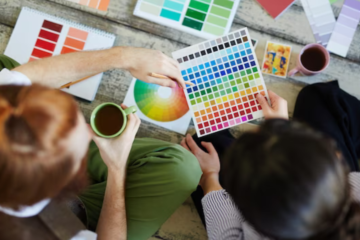In the vast realm of graphic design, typography stands as a cornerstone, influencing the visual language and impact of every design piece. The artful arrangement of type can elevate a design from ordinary to extraordinary, making mastery of typography an essential skill for graphic designers. This blog embarks on a journey to explore the nuances of typography, providing insights and techniques to enhance your design skills and create visually compelling and impactful compositions.
- Understanding the Basics:
- Before diving into the complexities of typography, grasp the fundamentals. Familiarize yourself with terminology, such as kerning, leading, and tracking, and understand the anatomy of typefaces – from serifs to sans-serifs, and everything in between.
- Choose Fonts Thoughtfully:
- Font selection is a critical decision in typography. Consider the personality of the typeface and its suitability for the intended message. Experiment with different font combinations to create visual interest and harmony in your designs.
- Hierarchy for Readability:
- Establishing hierarchy is essential for guiding the viewer’s eye and conveying information effectively. Use font sizes, weights, and styles strategically to emphasize important elements and create a clear visual hierarchy within your design.
- Balance and Proportion:
- Achieving a sense of balance and proportion is crucial in typography. Pay attention to the distribution of elements, spacing, and alignment to create a harmonious and visually pleasing composition.
- Experiment with Typography Styles:
- Typography offers a vast array of styles, from classic to modern, serif to sans-serif, and script to display fonts. Experiment with different styles to evoke various moods and cater to the specific requirements of each design project.
- Play with Color and Contrast:
- Color and contrast can elevate the impact of your typography. Experiment with color schemes that complement the overall design and use contrast to draw attention to key elements. Ensure readability by maintaining a sufficient contrast between text and background.
- Grid Systems and Alignment:
- Embrace grid systems to establish a structured layout for your typography. Align text elements consistently to create a sense of order and coherence. Grids serve as a foundation for organized and visually appealing typography.
- White Space as a Design Element:
- White space, or negative space, is a powerful design element. Embrace white space around your text to enhance readability and draw attention to key elements. Thoughtful use of white space contributes to a clean and sophisticated design.
- Customize for Branding:
- Tailor typography to suit the branding identity of a project or client. Customizing fonts or creating bespoke lettering can set your design apart and contribute to a unique and memorable brand identity.
- Stay Informed about Trends:
- Typography trends evolve, influenced by design movements, cultural shifts, and technological advancements. Stay informed about current typography trends while also developing a timeless aesthetic that transcends fleeting fads.
Conclusion: Typography mastery is a continuous journey of exploration, experimentation, and refinement. By delving into the principles of typography and practicing its art, graphic designers can transform their work into visually captivating and effective compositions. From understanding the basics to playing with styles, colors, and whitespace, every aspect of typography contributes to the overall impact of your designs. So, embark on the journey of mastering typography, and watch as your graphic design skills soar to new heights, leaving a lasting impression in the creative landscape.




